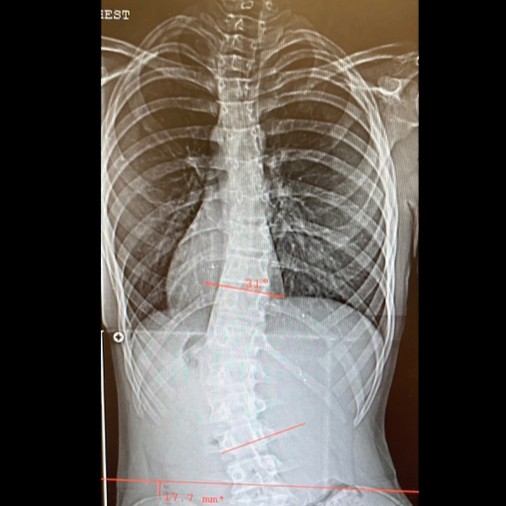My adolescent idiopathic scoliosis is a case of initial missed diagnosis. Nearly 14 years old, I experienced a rapid growth spurt during the COVID-19 pandemic. Classes were remote and without my long commute into school, the recommended 9 hours of sleep was finally within my reach. The slight rib hump extending out from the left of my spine now protruded. Concern was raised at my annual physical but a quick run of the office scoliometer put only my pediatrician at ease. That summer, my sternum began a slight push outward. A local orthopedist determined a chest brace was necessary but failed to order an x-ray despite a visible rib hump, slanted shoulder, and uneven hip alignment.


After an orthotist visit, I was fitted with my first brace. Choosing to keep my circumstance private to the outside world was an easy feat, since school and the world around me were shuttered due to the pandemic. I wore this painful brace for a year and grew another 5 inches. As I began leaning more to the right, my pediatrician suggested a podiatrist visit for a shoe lift. My mom had been worried that we weren’t getting the full picture and reached out to Children’s Hospital of Orange County to secure an orthopedist appointment. Within the month, we drove the +2 hours south where a nurse greeted me for a chest x-ray. The image appeared on a monitor that my parents and I stared at as we waited for the doctor. We finally had an answer as the doctor explained that my spine rotated forward and formed an S-shaped curve that would need to be braced due to adolescent idiopathic scoliosis. A TLSO Boston brace was made, to be worn 16 hours/day, that was restrictive, hot, and painful. I couldn’t figure out how to tolerably wear the brace at high school and wasn’t comfortable sharing my situation with anyone outside my family. So, all times outside of school, I wore this new brace for 1.5 years until I was 6’6” tall and well into 11th grade. With my extensive growth, the brace became ill fitting just around the time a family friend happened to mention Dr. Peter Newton at Rady Children’s Hospital. The summer prior to my senior year, I met Dr. Newton who began tracking my AIS. As my growth has slowed down, the risk of curvature lessened and I no longer wear a brace. It now sits in my closet as a reminder of a private journey.
My decision to become a Setting Scoliosis Straight Foundation Ambassador comes as I am now studying at university and have been able to reflect back more clearly on my journey with scoliosis. In high school, I chose to hide my personal experience and not share with anyone (not peers/teachers nor otherwise) but believe SSSF’s patient stories could have helped me connect to a broader supportive community. I hope that sharing my story can help other adolescents feel less alone in the treatment of scoliosis. As a SSSF Ambassador, I am committed to raising scoliosis awareness and research funding for treatment advancement.
Read more patient stories like this from around the world.





